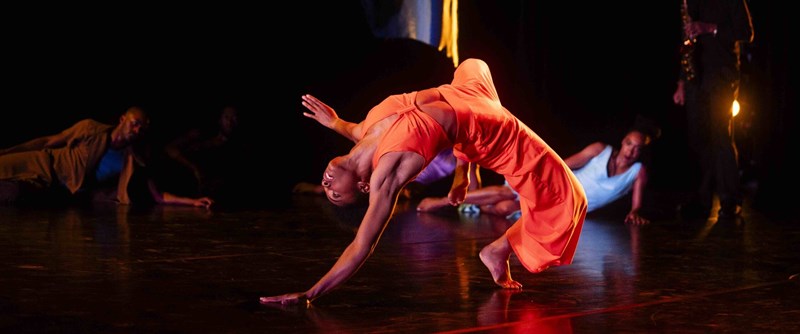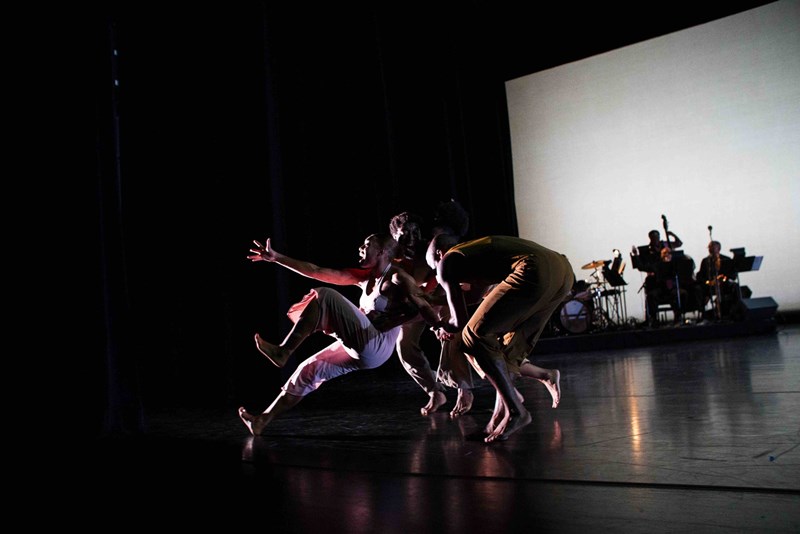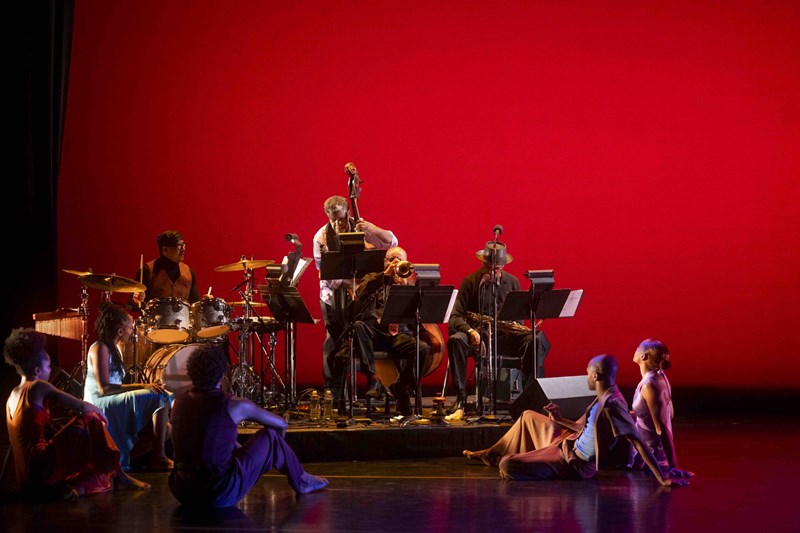In The Same Tongue Breathes Fresh Meaning into the Interplay of Music and Dance (4.5 stars)

In The Same Tongue, by The Dianne McIntyre Group, with Choreographer/Director Dianne McIntyre, Composer Diedre Murray, Poet Ntozake Shange, Company Artists Demetia Hopkins, Christopher Page-Sanders, Kyle H. Martin, Brianna Rhodes, and Kamryn Vaulx, Music Director Gerald Brazel, Costume Designer Devario Simmons, Lighting Designer Alan C. Edwards, Set Designer Riw Rakkulchon, Stage Manager Esther Bermann, Lighting Supervisor Neil Qiu, Tour Manager Adam Hyndman, Producer Octopus Theatricals, Trumpeter Gerald Brazel, Woodwinds Musician Cleave Guyton Jr., Bassist Ron Mahdi, Drums/Percussionist Reggie Nicholson, and Guest Dance Artists Haley Day, Francesca Lage, Laila Franklin, and Noli Rosen, runs September 26-29, 2024 at the Emerson Paramount Center in Boston.
Dianne McIntyre is celebrated as a legend in American modern contemporary dance. Her show, In the Same Tongue, is particularly notable for elevating the role of live music to the same level of importance as dance. Both elements are deeply personal to McIntyre’s identity, expression, and evolution as an artist.
The performance began with a silent, improvised solo by company artist Brianna Rhodes. Set against a dark stage, Rhodes’ figure was the sole focus commanding the audience’s attention. Without music, visual elements, or any other distractions, dance was the first and only “language” being spoken in this production. This setup encouraged the audience to extract meaning from movement alone, just as they would from words or song. Soon, lights illuminated a four-person band consisting of a trumpeter, saxophonist, bassist, and percussionist. They began playing jazzy melodies, the second “language” introduced, as Rhodes was joined by four other company artists onstage.
The dancers, all improvising, initially reflected the style and technique associated with American modern dance. Gradually, each dancer began to alter their movements to resemble those of casual club-goers in the 50s and 60s, swinging, grooving, and gyrating in ways that suggested a possession by the Holy Ghost. This shift in style demonstrated their responsiveness to the music, showcasing the conversation between sound and movement. At one point, the band members joined the dancers on the floor, bringing various handheld instruments with them.
Each band member performed a duet with a company artist, developing in real time an unrehearsed collaboration. As each duet took center stage, the boundary between sound and movement slowly disappeared. This interplay emphasized McIntyre’s belief in the interchangeability of music and dance as forms of expression. The audience was invited to witness the seamless integration of these two art forms, each enhancing the other.

Throughout the production, McIntyre spoke in passages that provided context, history, and transitions that served to illuminate the messages behind the movement and sound. Her words pieced together this coming of age story as dancer, music lover, and radical thinker. These spoken elements were particularly helpful for those not accustomed to storytelling through dance and music. However, each passage usually followed the musical dance piece it explained, requiring the audience to rely first on their own analysis. This can be challenging for those new to dance-centered productions. But like a lexicon, McIntyre’s recitations helped translate each piece, aiding the audience in receiving the appropriate interpretation.
Certain pieces were quite enigmatic in their own right. For instance, there was a silent duet where two dancers performed the same choreography while facing away from each other. Without any sounds or music to guide them, their synchronization was impressive. In another piece, four additional dancers, local to Boston but not members of the company, joined the company artists in a performance where the only sounds were their voices saying “What?,” “What about?,” “I don’t know,” and “Maybe.”

McIntyre then explained how liberated, improvisational jazz music made people think, critique, and challenge norms, which is why such music was often kept out of the mainstream. This explanation provided an “Aha!” moment for understanding the dancers’ prior random vocalizations. While music and dance were the primary languages used to convey meaning, often wrapped in layers of complexity, McIntyre’s passages helped translate raw experiences into simple words. They acted as a bridge, connecting the audience to the deeper themes of the performance.
Additionally, certain pieces included poetry, written by Ntozake Shange, were spoken by the dancers themselves while in the midst of their movement. It was a reminder that neither dance nor the dancer are voiceless. Both their movement and poetic recitations carried rhythm, striking punctuation, and at times enigma. Like McIntyre’s spoken passages, these poems often grounded dances in context and focused the audience on specific themes, such as the African diaspora.

This production effectively conveyed Dianne McIntyre’s personal story and connection with dance and music, situating it within the context of the Black American cultural revolution. Her innovative approach and the talented performers brought this vision to life. In the Same Tongue may be challenging for those new to narratives delivered primarily through modern contemporary dance. However, with the aid of verbal explanations, In The Same Tongue earns 4.5 out of 5 stars for immersing its audience in its chosen languages and messages.
For more, see artsemerson.org and see our interview with Ronee Penoi, Director of Artistic Programming at ArtsEmerson.